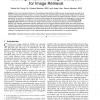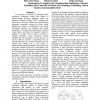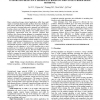26 search results - page 5 / 6 » What are the high-level concepts with small semantic gaps |
TKDE
2008
13 years 5 months ago
2008
One of the fundamental problems in Content-Based Image Retrieval (CBIR) has been the gap between low-level visual features and high-level semantic concepts. To narrow down this gap...
ESWA
2007
13 years 6 months ago
2007
In this paper we present an automatic facial expression recognition system that utilizes a semantic-based learning algorithm using the analytical hierarchy process (AHP). Although...
GI
1997
Springer
13 years 10 months ago
1997
Springer
Object-Gofer is a small, practical extension of the functional programming language Gofer incorporating the following ideas from the object-oriented community: objects and toplevel...
MIR
2004
ACM
13 years 11 months ago
2004
ACM
In content-based image retrieval, relevance feedback has been introduced to narrow the gap between low-level image feature and high-level semantic concept. Furthermore, to speed u...
ICASSP
2007
IEEE
14 years 10 days ago
2007
IEEE
Many content-based image retrieval applications suffer from small sample set and high dimensionality problems. Relevance feedback is often used to alleviate those problems. In thi...



